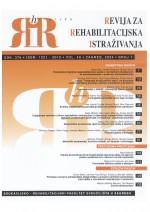Evaluacija programa osposobljavanja osoba s mentalnom retardacijom za samozastupanje u području samopoštovanja
The evaluation of the programme for improving self-advocacy adults with learning disabilities in the area of self-esteem
Author(s): Marija Bilić, Daniela Bratković, Branko NikolićSubject(s): Psychology, Inclusive Education / Inclusion
Published by: Sveučilište u Zagrebu, Edukacijsko-rehabilitacijski fakultet
Keywords: self-advocacy; self-esteem; mental retardation; program; evaluation;
Summary/Abstract: The appearance of the philosophy of inclusion and social model has caused significant changes in society's relation towards persons with difficulties, thus including, also persons with mental retardation. These changes were significantly contributed to by the self-advocacy movement. With the appearance of the philosophy of inclusion in our midst as well, the need has arised to enable persons with mental retardation to become self-advocates and join the social community's life. The aim of the present research was to establish and evaluate the efficiency of the self-advocacy experimental training program regarding its application when working with adults with mental retardation in the area of self-esteem. Specific objectives were aiming, at determining the difference in the self-esteem level among respondent groups. The pattern consisted of two groups of I6 respondents. The first respondent group spent most part of their lives at an institution and have been deinstitutionalized from it just before the initial questioning. The second respondent group lives in their own families. Componential analysis of changes in respondent pattern described by an assembly of quantitative variables has shown a statistically significant progress in the achievements of bouth respondent groups.Variance analysis and robust discrimination analysis has established - in both the initial and the final state, statistically significant differences among the two respondent groups in all measurement areas-
Journal: Hrvatska revija za rehabilitacijska istraživanja
- Issue Year: 39/2004
- Issue No: 1
- Page Range: 1-12
- Page Count: 12
- Language: Croatian

